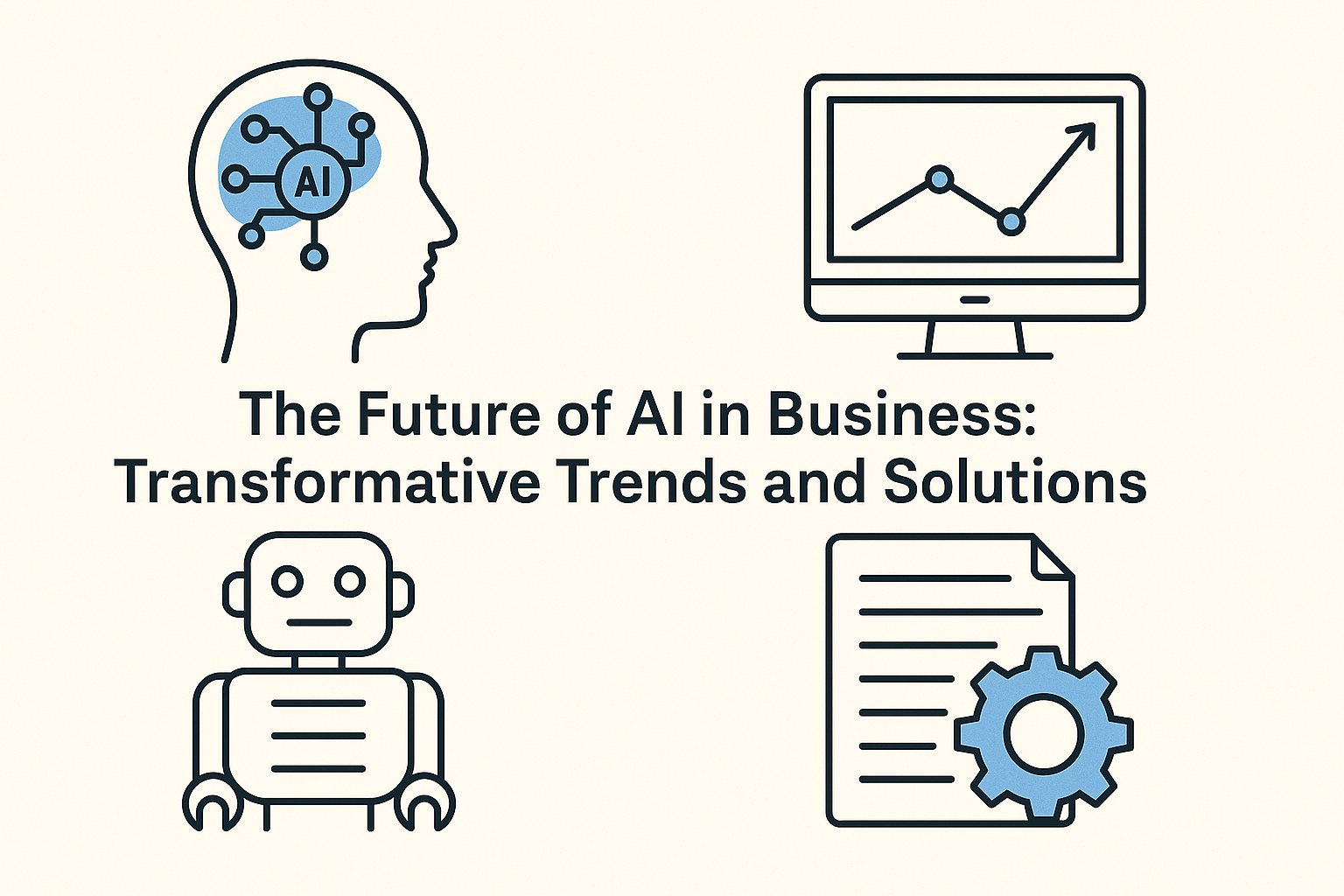Artificial intelligence has rapidly evolved from a futuristic concept into a tangible force reshaping the business world. As we look towards the future of AI, its integration into various industries promises to revolutionize how companies operate, innovate, and compete.
From streamlining operations and enhancing customer experiences to driving strategic decision-making, AI in business is set to unlock unprecedented opportunities and challenges.
In this article, we delve into the transformative trends and cutting-edge artificial intelligence solutions poised to redefine industry landscapes in 2024 and beyond. Join us as we explore the profound impact of AI on industry and unveil the key AI trends that will shape the business ecosystem.
The Rise of AI in Business
The integration of AI into business operations marks a pivotal shift in how companies function and compete. This section explores the transformative impact of AI across industries, its role in reshaping traditional practices, and the emerging trends.
Impact of AI on Industry
AI is revolutionizing industries across the board, from manufacturing to healthcare, finance to retail. Its ability to process vast amounts of data and derive actionable insights is unparalleled.
In manufacturing, AI-powered predictive maintenance is reducing downtime and optimizing production schedules. The healthcare sector is benefiting from AI’s diagnostic capabilities and personalized treatment plans.
Financial institutions are leveraging AI for fraud detection and risk assessment, while retailers are enhancing customer experiences through AI-driven personalization and inventory management.
The impact of AI on industry is quantifiable:
-
61% of businesses reported cost savings due to AI implementation
-
45% experienced increased productivity
-
32% saw improvements in customer satisfaction

Transforming Traditional Practices
AI is reshaping long-established business practices, introducing efficiency and innovation across various domains.
In human resources, AI-powered tools are streamlining recruitment processes, from resume screening to candidate assessment. This not only saves time but also reduces bias in hiring decisions.
Marketing departments are utilizing AI for data-driven campaign optimization and personalized content creation. The result is more targeted and effective marketing strategies.
Supply chain management has been revolutionized by AI’s predictive capabilities, enabling better demand forecasting and inventory optimization. This leads to reduced costs and improved customer satisfaction.
AI Trends 2024: What’s Next?
As we look towards 2024, several AI trends are poised to shape the business landscape:
-
Explainable AI (XAI): Increasing focus on transparency and interpretability of AI decision-making processes.
-
AI-powered cybersecurity: Advanced threat detection and response systems to combat evolving cyber threats.
-
Edge AI: Processing data closer to its source for faster, more efficient operations.
The integration of AI with other emerging technologies like blockchain and IoT will create new synergies and opportunities for innovation.
Businesses that stay ahead of these trends will be better positioned to leverage AI’s full potential and maintain a competitive edge in their respective industries.
AI-Powered Solutions for Enterprises
AI solutions are transforming how enterprises operate, interact with customers, and drive innovation. This section delves into the practical applications of AI across various business functions.
Streamlining Operations with AI
AI is revolutionizing business operations, enhancing efficiency and reducing costs across various departments.
In supply chain management, AI algorithms optimize inventory levels and predict demand fluctuations with unprecedented accuracy. This leads to reduced waste, lower storage costs, and improved customer satisfaction.
AI-powered robotic process automation (RPA) is streamlining repetitive tasks in finance and administration. From invoice processing to data entry, RPA frees up human resources for more strategic work.
Predictive maintenance, enabled by AI and IoT sensors, is transforming asset management. By anticipating equipment failures before they occur, businesses can minimize downtime and extend the lifespan of their assets.
Enhancing Customer Experiences
AI is redefining customer interactions, enabling personalized, efficient, and proactive service across multiple touchpoints.
Chatbots and virtual assistants, powered by natural language processing, provide 24/7 customer support. They can handle routine inquiries, freeing up human agents for more complex issues.
AI-driven recommendation engines analyze customer behavior to offer personalized product suggestions. This not only enhances the shopping experience but also increases cross-selling and upselling opportunities.
Sentiment analysis tools help businesses gauge customer satisfaction in real-time, allowing for quick responses to negative feedback and improved overall service quality.
Driving Innovation and Growth
AI is catalyzing innovation across industries, opening up new avenues for growth and competitive advantage.
In product development, AI-powered simulations and prototyping tools accelerate the design process and reduce time-to-market. This allows businesses to iterate faster and stay ahead of market trends.
AI’s predictive capabilities are enhancing strategic decision-making. By analyzing market trends, consumer behavior, and competitive landscapes, AI helps businesses identify new opportunities and mitigate risks.
In the realm of research and development, AI is accelerating drug discovery in pharmaceuticals and materials science innovations in manufacturing, potentially leading to groundbreaking advancements.
Challenges and Considerations
While AI offers immense potential, its integration into business operations comes with significant challenges. This section explores the ethical considerations, implementation hurdles, and strategies for long-term success with AI.
Navigating Ethical Dilemmas
As AI becomes more prevalent in decision-making processes, businesses must grapple with complex ethical considerations.
The issue of bias in AI algorithms is a critical concern. AI systems can inadvertently perpetuate or amplify existing biases, leading to unfair outcomes in areas such as hiring, lending, or criminal justice.
Data privacy and security present another ethical challenge. As AI systems require vast amounts of data to function effectively, businesses must ensure they collect and use this data responsibly and in compliance with regulations like GDPR.
Transparency and accountability in AI decision-making are crucial. Businesses need to be able to explain how their AI systems arrive at certain conclusions, especially in high-stakes scenarios.
Managing AI Integration
Integrating AI into existing business processes requires careful planning and execution to ensure smooth adoption and maximize benefits.
Key steps in managing AI integration include:
-
Assessing current processes and identifying areas where AI can add value
-
Ensuring data quality and accessibility to support AI algorithms
-
Upskilling employees to work alongside AI systems
-
Establishing governance frameworks for AI deployment and monitoring
Collaboration between IT teams, domain experts, and business leaders is crucial for successful AI integration. This cross-functional approach ensures that AI solutions align with business objectives and operational realities.
Future-Proofing Your Business
To stay competitive in an AI-driven future, businesses must adopt a forward-thinking approach to technology adoption and organizational culture.
Investing in scalable AI infrastructure allows businesses to adapt to evolving technologies and changing market demands. This includes cloud computing resources, data management systems, and flexible AI platforms.
Fostering a culture of continuous learning is essential. Encourage employees to develop AI literacy and provide opportunities for upskilling in areas such as data analysis and machine learning.
Staying informed about emerging AI trends and regulations helps businesses anticipate changes and adapt their strategies accordingly. This proactive approach ensures long-term resilience in a rapidly evolving technological landscape.
The Global Impact of AI
AI’s influence extends far beyond individual businesses, reshaping entire industries and economies on a global scale. This section examines how AI is bridging gaps, influencing markets, and transforming the workforce.
Bridging Industry Gaps
AI is breaking down traditional barriers between industries, fostering innovation and collaboration across sectors.
In healthcare and technology, AI is enabling the development of advanced diagnostic tools and personalized treatment plans. This convergence is accelerating medical research and improving patient outcomes.
The finance and retail sectors are leveraging AI to create seamless, omnichannel customer experiences. From AI-powered financial advisors to personalized shopping recommendations, these cross-industry applications are redefining consumer expectations.
AI is also bridging gaps in sustainability efforts. By optimizing energy consumption and resource allocation across industries, AI is playing a crucial role in addressing global environmental challenges.
Influencing Global Markets
AI is reshaping global markets, influencing investment strategies, and creating new economic opportunities.
In financial markets, AI-powered algorithmic trading is increasing market efficiency and liquidity. However, it also raises concerns about market volatility and the need for updated regulatory frameworks.
AI is driving the growth of new markets, such as the AI chip industry and AI-as-a-Service platforms. These emerging sectors are attracting significant investment and reshaping the technology landscape.
The global AI market is expected to reach $190.61 billion by 2025, with key growth areas including:
-
Natural Language Processing: 26.3% CAGR
-
Robotics: 23.7% CAGR
-
Computer Vision: 19.6% CAGR
Shaping the Workforce of Tomorrow
AI is fundamentally altering the job market, creating new roles while transforming existing ones.
While concerns about job displacement persist, AI is also creating new job categories. Roles such as AI ethicists, machine learning engineers, and data scientists are in high demand.
The skills required in the workforce are evolving. Emphasis is shifting towards uniquely human skills like creativity, emotional intelligence, and complex problem-solving, which complement AI capabilities.
Businesses and educational institutions are adapting to these changes by:
-
Developing AI literacy programs
-
Offering reskilling and upskilling opportunities
-
Fostering collaboration between humans and AI systems
Preparing for the AI Revolution
As AI continues to reshape the business landscape, organizations must proactively prepare for this technological revolution. This section outlines strategies for embracing AI solutions, cultivating an AI-ready culture, and planning for successful AI adoption.
Embracing Artificial Intelligence Solutions
To effectively leverage AI, businesses need to identify and implement solutions that align with their specific needs and goals.
Start by conducting a thorough assessment of your current processes and pain points. This will help pinpoint areas where AI can add the most value, whether it’s in customer service, operations, or decision-making.
When selecting AI solutions, consider factors such as:
-
Scalability and flexibility
-
Integration with existing systems
-
Data requirements and privacy considerations
-
Total cost of ownership, including implementation and maintenance
Remember that AI implementation is an iterative process. Begin with pilot projects to test and refine your approach before scaling up.
Building an AI-Ready Culture
Creating a culture that embraces AI is crucial for successful adoption and long-term success.
Foster a data-driven mindset across your organization. Encourage employees to base decisions on insights derived from data and AI analysis rather than gut feelings or tradition.
Invest in AI literacy programs to help employees understand the basics of AI, its potential applications, and its limitations. This knowledge will help reduce fear and resistance to AI adoption.
Promote collaboration between human employees and AI systems. Emphasize that AI is a tool to augment human capabilities, not replace them entirely.
Strategic Planning for AI Adoption
A well-thought-out strategy is essential for successful AI adoption and integration into your business operations.
Key elements of an AI adoption strategy include:
-
Setting clear objectives and KPIs for AI initiatives
-
Establishing a cross-functional AI team to oversee implementation
-
Developing a robust data strategy to ensure high-quality inputs for AI systems
-
Creating an ethical framework for AI use within your organization
-
Planning for ongoing monitoring and optimization of AI systems
Remember to align your AI strategy with your overall business goals and vision. AI should be a means to achieve your business objectives, not an end in itself.
By embracing AI solutions, fostering an AI-ready culture, and strategically planning for AI adoption, businesses can position themselves to thrive in the AI-driven future of industry.




